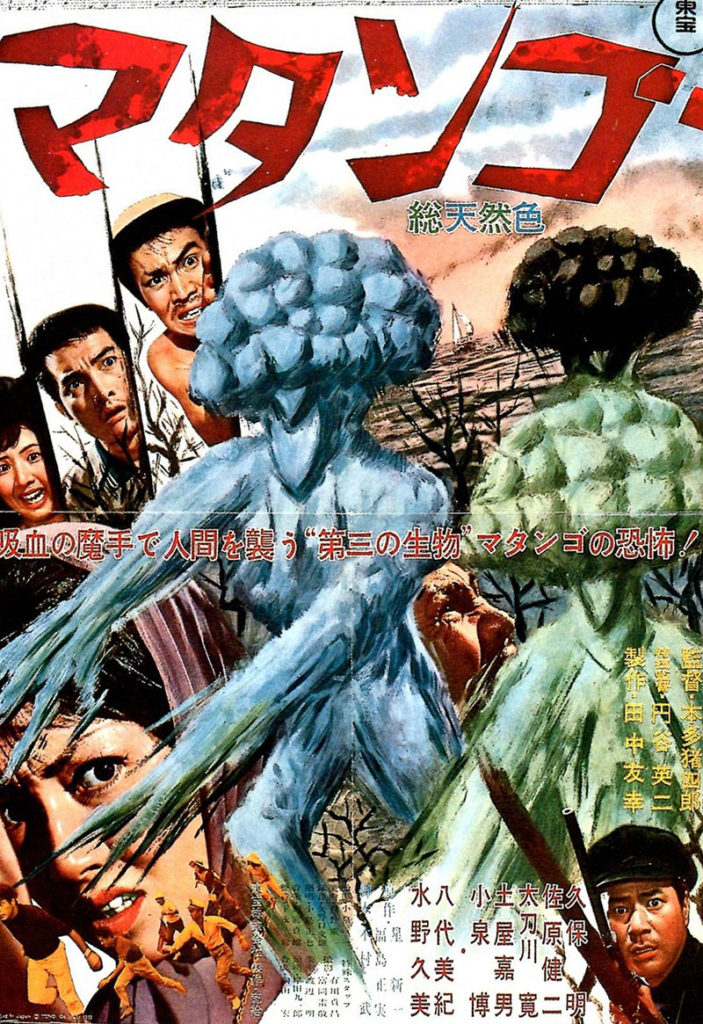Forget the original title of Matango. It was the Americanized title of Attack of the Mushroom People that grabbed my attention. People that look like giant fungi on the attack? Sign me up. I’m not naïve about movies like this. I know, before ever seeing it, that a title like that promises more than it can deliver, but I’m okay with it. Should the film be dragged out and the mushroom people only make significant appearances during the last few minutes, that’s just fine by me. I wanted this movie to be bad, after all. And it is!
Matango, from 1963, is a Japanese film from legendary kaiju filmmaker, and occasional assistant director to Akira Kurosawa, Ishiro Honda. The film follows a group of seven pleasure boaters who are caught in a storm west of Kyushu. The storm de-masts their sailboat and damages the engine, setting the group adrift. For good measure, and to aid the plot, the boat’s radio is busted, as well.
After a few days of drifting, the boat reaches a mysterious volcanic island. The group, hungry and thirsty, goes ashore to find food and, hopefully, rescue. There is no rescue to be had, however, as the island is deserted. But, people have been there before. On the far side of the island from where the group landed they find a barque fetched up on the beach. There’s no sign of passengers or crew. Also, it appears the ship was being used as a research vessel of some sort. Either way, the group decides to use the ship as shelter while they hunt for food and try and repair the sailboat.
There is plenty of potential food on the island. There’s a grove of flowering mushrooms nearby, but the group wisely stays away in case they are poisonous. Otherwise, the pickings are kind of slim. One of the group, Senzo (Kenji Sahara), has his own little black market, selling sea turtle eggs to wily businessman Kasai (Yoshio Tsuchiya).
Lack of food and being stranded aren’t the only problems facing the group, however. The mushroom grove is indicative of a fungal infestation affecting the entire island — one that may have something to do with the missing crew of the ship. One night, as Kasai is raiding the  meager food stores on the ship, he is confronted by a man with a severely deformed head. It is a terrifying presence, and one that everyone in the group sees as it stands in the hatchway of the main cabin. But then that’s it. We see it, fade to black, and the next scene begins by showing the group discussing what they have seen.
meager food stores on the ship, he is confronted by a man with a severely deformed head. It is a terrifying presence, and one that everyone in the group sees as it stands in the hatchway of the main cabin. But then that’s it. We see it, fade to black, and the next scene begins by showing the group discussing what they have seen.
It’s a jarring transition and a moment of supremely shitty filmmaking. It was as if Honda provided a scare for his audience in showing the deformed creature, then decided that was enough and moved on to the next scene, without providing any resolution whatsoever. It makes no sense. But it does fit in with the overall quality of the film.
There is some ambitious stuff in here, though. Honda was not an incompetent filmmaker, but he took a lot of shortcuts in this film. What does work is a lively visual style and a whole lot of kitsch. Every one of the characters is a cliché, from the crooked Senzo, to the flamboyant (for 1960s Japan) novelist Yoshida (Hiroshi Tachikawa), to the square-jawed, morally upright hero Kenji (Akira Kubo). The color palette is bright and somewhat psychedelic, as well.
The finale of the film, after a viewer has endured over an hour of setup, is one of the more outrageous finales one can find in a movie about killer plants or fungi or whatever stalking human beings. Sure, it’s a short list, and when one’s competition is The Day of the Triffids and The Navy vs. the Night Monsters, it’s easy to shine. But, when those mushroom people make their appearance in full regalia, with a bizarre soundtrack to boot, it makes the entire shitty journey worth it. Still, Alien: Resurrection is a better movie than Matango.
